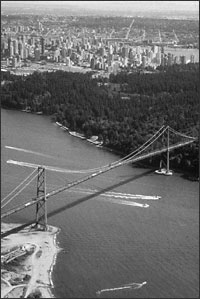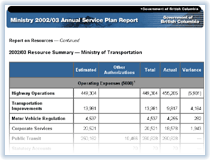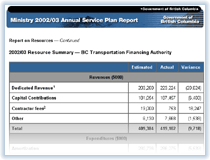 |
|
|
 |
 |
2002/03 Annual Service
Plan Report
Ministry of Transportation |
 |
 |
Report on Resources
2002/03 Resource Summary — Ministry
of Transportation
2002/03 Resource Summary — BC Transportation
Financing Authority
Complete BC Transportation Financing Authority Financial Statements
are available in Appendix 3.
Major Capital Projects
Nisga'a Highway
Objectives:
The key component of the Nisga'a Highway project is the
upgrading of the gravel resource road in the Nass Valley. The road
is a vital connection between three Nisga'a communities,
linking them with Terrace and the provincial highway network. The
province is continuing a seven-year investment program with two
components:
- upgrading the Nisga'a Highway to an all weather two-lane
highway (general 70 kilometre per hour standard) to better serve
Nass Valley residents and resource industries in the area.
- construction of the new Greenville to Kincolith road to open
up access to the Village of Kincolith. This project is financed
under a cost sharing partnership comprising the federal and provincial
governments and the Nisga'a Tribal Council.
Costs:
- The estimated total project cost for the Nisga'a Highway
Upgrade is $52 million. Expenditures to March 31, 2003 are $25.1
million.
- The estimated total project cost for Greenville-Kincolith Road
(new route) is $34.6 million ($17.5 million provincial share).
Expenditures to March 31, 2003 are $32.5 million.
Benefits:
- Safety, access and mobility improvements.
- Increased economic development (e.g. tourism).
Risks:
- Technical and financial risks. The Greenville to Kincolith route
traverses some very rugged terrain, including sections where high
cliffs drop sharply to the Nass River. The project presents numerous
engineering and construction challenges.
Kicking Horse Canyon
Objectives:
The improvement program for the Kicking Horse Canyon involves upgrading
the 26-kilometer section of the Trans Canada Highway between Golden
at the junction of Highway 95 and the western boundary of Yoho
National Park to a modern four-lane standard. This investment would
represent a major service improvement to the Trans Canada Highway
and is directed at:
- responding to continual and severe safety problems;
- minimizing road closures due to slides and accidents;
- replacing of two major structures that are nearing the end of
their service lives;
- supporting the efficient movement of goods and services;
- facilitating trade and commerce;
- supporting tourism and associated local business opportunities;
and
- augmenting the capacity of a critical provincial/national gateway.
Costs:
The estimated capital cost of the improvement program is $730 million.
The upgrade will proceed in three phases:
- 5-Mile (Yoho) Bridge ($61 million). This work is being cost
shared with the Government of Canada under the Strategic Highway
Infrastructure Program (SHIP): $23 million federal and $38 million
provincial. Construction is in progress and expenditures to March
31, 2003 are $19.2 million. Construction of this section is on
target and is expected to be completed by fall 2006.
- 10-Mile (Park) Bridge ($130 million). This work is being cost
shared with the Government of Canada under the Strategic Infrastructure
Fund (SIF): $62.5 million federal and $67.5 million provincial.
Construction is in progress and expenditures to March 31, 2003
are $2.3 million. Financing and project delivery options through
a public-private partnership are being investigated.
- Golden to 5-Mile and 10-Mile to Yoho National Park. The estimated
total cost of constructing these two sections and final third
phase is $539 million. The federal government had made no commitment
to cost sharing on this section as of the end of 2002/03.
Benefits:
- The net present value of the 5-Mile (Yoho) Bridge and 10-Mile
(Park Bridge) sections is $110 million based on safety, travel
time, reliability and economic development benefits.
Risks:
- Technical Risk: Rock and slope stability and climatic conditions.
- Financial Risk: Possible construction problems due to difficult
topography and material costs.
- Uncertainty around ongoing availability of federal funding.
Okanagan Lake Bridge
Objectives:
- Construct a new four lane bridge (expandable to five lanes)
to reduce congestion in peak hours and through the summer. Includes
construction of a couplet system in downtown Kelowna to improve
traffic flow and the addition of a truck climbing lane on the
west side of Okanagan Lake.
- Reduce travel time from the South to the Central Okanagan and
facilitate tourism, goods movement and business travel.
Costs:
- The estimated total cost of the project is $100 million. Financing
and project delivery options through a public private partnership
are being investigated.
- Expenditures to March 31, 2003 are $7.6 million for the project
development and design.
Benefits:
- The net present value of the benefits of the project is $109.1
million, and includes improved safety, travel time savings and
economic development.
Risks:
- Technical Risk: The risks associated with the construction of
floating bridges have been substantially reduced in recent years
with the introduction of new flotation technologies.
- Financial Risk: Possible construction problems due to engineering
challenges.
- Schedule Risk: The delivery of the project through the P3 process
may delay the initial construction of the bridge.
Sea-to-Sky Highway
Objectives:
The Sea-to-Sky Highway Upgrade is part of a long-term corridor
improvement needs project. It involves critical safety improvements
to Highway 99 (Sea-to-Sky), and lane expansions along certain sections
of the highway between Horseshoe Bay and Whistler. The upgrade addresses
continual and severe safety and mobility concerns, will reduce road
closures due to slides and accidents, and at the same time will
meet the requirements of the 2010 Olympic Bid.
Costs:
- The estimated project cost is $600 million, and expenditures
to March 31, 2003 are $10.4 million related to environmental
studies, geotechnical investigations, financing and procurement
strategies, traffic management planning, consultation with stakeholders,
and technical support for the 2010 Olympic bid.
Benefits:
- The estimated value of user benefits over the period 2010 to
2025 is $873 million, and includes travel time savings, operating
and accident cost savings.
Risks:
- Technical Risk: Rock and slope instability and climatic conditions.
- Financial Risk: Possible construction problems due to difficult
topography and material costs.
Lions Gate Bridge

Objectives:
- Replace the aging bridge deck to reduce maintenance costs
and eliminate the possibility of deck failure.
- Create a safer and more efficient route for motor vehicles,
cyclists and pedestrians.
Costs:
- The project budget was $125 million. Expenditures to March
31, 2003 are $124 million. The project was completed during
2002/03.
Benefits:
- Increased safety and extended useful life of the bridge.
Risks:
- Risks became negligible with project completion.
Vancouver Island Highway
Objectives:
- Provide a transportation corridor that addresses the needs
of Vancouver Island residents, visitors and the economy, and
improves safety.
Costs:
- The project budget was $1.3 billion, and expenditures for
the 2002/03 fiscal year were $30.6 million. The project was
formally initiated in 1993/94, and is now complete with total
expenditures to March 31, 2003 of $1.3 billion.
Benefits:
- Benefits include time savings, reductions in the number of
traffic accidents of up to 60 per cent in some sections, and
reduced vehicle operating costs.
Risks:
- Risks became negligible with project completion.
|
|




